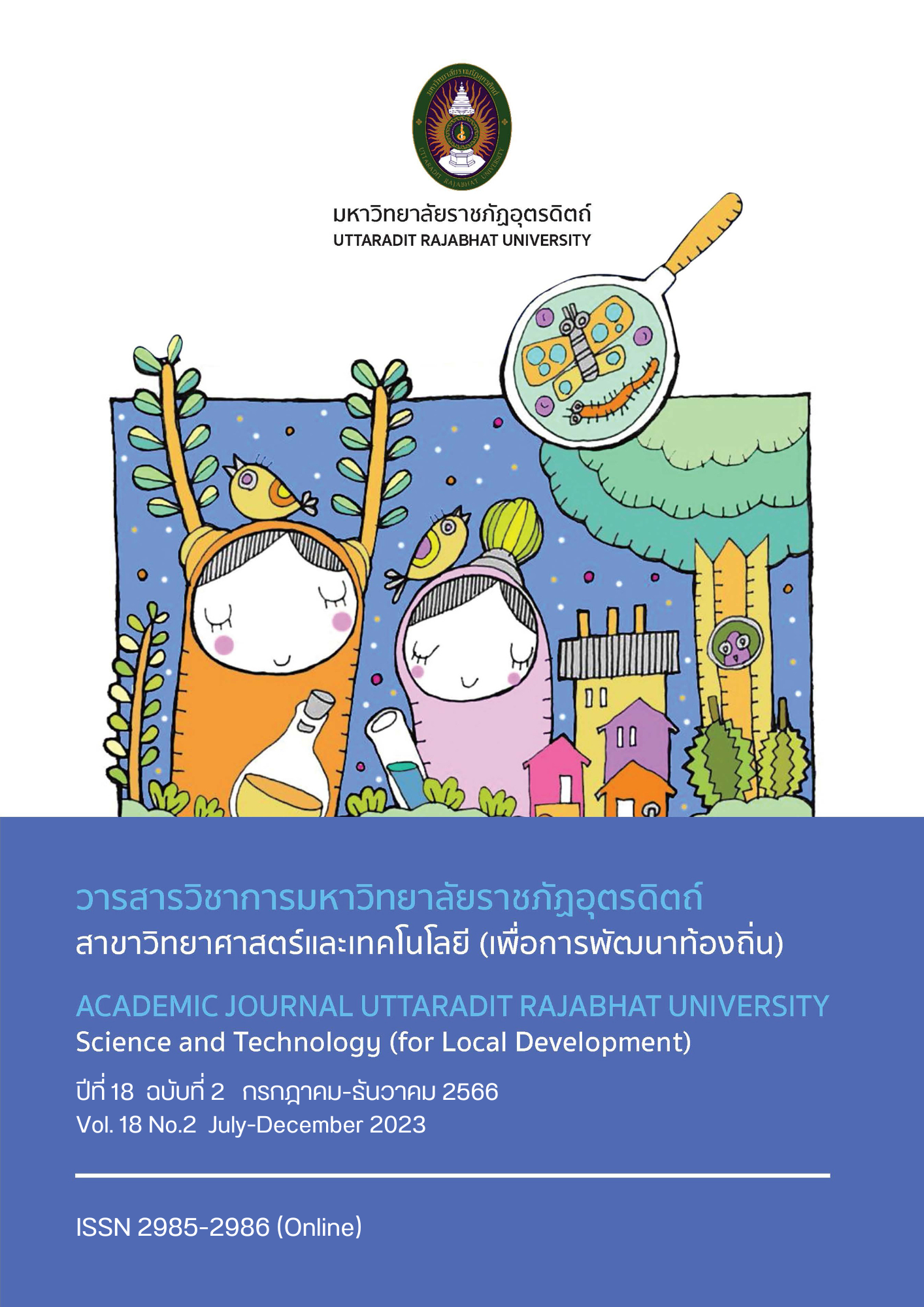THE DEVELOPMENT OF LOESS SOIL MIXED CEMENT FOR CONSTRUCTION RAMMED EARTH WALL : A CASE STUDY OF SOIL IN KHONKAEN PROVINCE
Main Article Content
Abstract
The objectives of this study were 1) develop Khon Kaen loess soil for use in the construction of earth house with compressed grinding techniques, and 2) to investigate the engineering properties of the rammed earth wall by mixing cement and loess soils at a ratio of 1:6 compressed by standard method with optimum moisture content of 9.40 %. The test of water absorption was performed with a sample of 7.5 x 7.5 x 7.5 cm. And test of the compressive strength was also performed by simulating it as a small wall model, and the sample was 0.60 x 0.60 m. at 7.5, 10, 12.5 and 15 cm. thick with the curing ages of 7, 14 and 28 days, respectively. The results showed that the construction of rammed earth wall with the first layer of compression grinding with a height of 60 cm. was completed, the rammed earth wall must be allowed for a setting time of 24 hours before the next layer was compacted. After that, the rammed earth wall was cured for 14 days before being used for the development of the compressive strength of the masonry infill wall. The engineering properties of rammed earth wall of 24-hour water absorption was 10.56%. The optimum thickness of rammed earth wall in was found to be 12.5 cm. thick due to the compression capacity value at 14-day curing time of 45.16 ksc. with the highest slenderness ratio with compression capacity through the compression capacity of different types of masonry prism. The results of this study were helpful for general people who would like to use the soil in the area to build the rammed earth wall and the application of the bricks mixed with cement to generate income for the community.
Downloads
Article Details

This work is licensed under a Creative Commons Attribution-NonCommercial-NoDerivatives 4.0 International License.
References
ชินะวัฒน์ มุกตพันธุ์. (2561). ปฐพีกลศาสตร์. (พิมพ์ครั้งที่ 5). มหาวิทยาลัยขอนแก่น.
ชูศักดิ์ คีรีรัตน์ และสุธน รุ่งเรือง. (2562). การพัฒนาก้อนอิฐดินดิบผสมใบกล้วยและขุยมะพร้าวเพื่อเป็นวัสดุก่อสร้างสำหรับบ้านดิน. วารสารวิศวกรรมศาสตร์ มหาวิทยาลัยเทคโนโลยีราชมงคลล้านนา, 4(1), 8-15.
วิหาร ดีปัญญา และกิตติพงษ์ สุวีไร. (2560). การพัฒนาผนังบ้านดินสำเร็จรูปที่ต้านทานการชะล้างสูงและเป็นฉนวนป้องกันความร้อนที่ดีสาหรับอาคารอนุรักษ์พลังงานและสิ่งแวดล้อม (รายงานการวิจัย). มหาวิทยาลัยเทคโนโลยีราชมงคลพระนคร. https://repository.rmutp.ac.th/xmlui/bitstream/handle/123456789/3152/ENG_62_03.pdf?sequence=1&isAllowed=y
สำเนียง องสุพันธ์กุล, วราธร แก้วแสง และสาโรจน์ ดำรงศีล. (2559). พฤติกรรมทางกลของผนังดินซีเมนต์บดอัดภายใต้แรงกดอัดสำหรับบ้านดิน. การประชุมวิชาการระดับชาติ มหาวิทยาลัยเทคโนโลยีราชมงคลรัตนโกสินทร์ ครั้งที่ 1: เรื่อง นวัตกรรมอาคาร 2559 (น. 11-20). มหาวิทยาลัยเทคโนโลยีราชมงคลรัตนโกสินทร์.
อธิปัตย์ อภิชาโรจนศักดิ์. (2561). การพัฒนาอิฐบล็อกประสานชนิดรับน้ำหนักโดยใช้ดินลมหอบผสมกับแกลบ [วิทยานิพนธ์ไม่มีการตีพิมพ์]. มหาวิทยาลัยราชภัฎมหาสารคาม.
อนุชาติ ลี้อนันต์ศักดิ์ศิริ. (2565). การศึกษากำลังรับแรงผนังอิฐก่อภายใต้การทดสอบด้วยเพนดูลัมเทส. การประชุมวิชาการและนำเสนอผลงานวิจัยระดับชาติครั้งที่ 9 และระดับนานาชาติ ครั้งที่ 7 มหาวิทยาลัยภาคตะวันออกเฉียงเหนือ (น. 503-514). มหาวิทยาลัยภาคตะวันออกเฉียงเหนือ.
American Society for Testing and Materials. (2000). ASTM D4318: Standard test method for liquid limit plastic limit and plasticity index of soil. ASTM International. https://kashanu.ac.ir/Files/D%204318%20-%2000%20%20_RDQZMTG_.pdf
American Society for Testing and Materials. (2002). ASTM D422: Standard test method for particle-size analysis of soils. ASTM International. https://www.epa.gov/sites/default/files/2020-01/documents/sedc_2004-2005_append.pdf
American Society for Testing and Materials. (2014). ASTM D854:Standard test methods for specific gravity of soil solids by water pycnometer. ASTM International. https://tajhizkala.ir/doc/ASTM/D854-14.pdf
American Society for Testing and Materials. (2018). ASTM C39:Standard test method for compressive strength of cylindrical concrete specimens. Ed Webster. https://www.scribd.com/document/426461320/ASTM-C39-Compressive-Strength-of-Cylindrical-Concrete-Specimens-pdf
American Society for Testing and Materials. (2018). ASTM D4221: Standard test method for dispersive characteristics of clay soil by double hydrometer. ASTM International. https://webstore.ansi.org/standards/astm/astmd422118
American Society for Testing and Materials. (2021). ASTM D698: Standard test methods for laboratory compaction characteristics of soil using standard effort. ASTM International. https://www.astm.org/d0698-12r21.html
Arun, L., Sarangapani, G., & Prasanna, H. S. (2021). Characteristics of high strength stone masonry using cement-soil mortar. Turkish Journal of Computer and Mathematics Education, 12(10), 3826-3841.
Balaguer, L., Vegas López-Manzanares, F., Mileto, C., & García-Soriano, L. (2019). Assessment of the thermal behaviour of rammed earth walls in the summer period. Sustainability, 11(7), 1924. https://doi.org/10.3390/su11071924
Bui, Q. B., Morel, J. C., Reddy, B. V., & Ghayad, W. (2009). Durability of rammed earth walls exposed to 20 years to natural weathering. Building and Environment, 44(5), 912-919. https://doi.org/10.1016/j.buildenv.2008.07.001
Davidson, D. T., Pitre, G. L., Mateos, M., & George, K. P. (1962). Moisture - density, Moisture – strength and compaction characteristic of cement – treated soil mixture, 41st Annual Meeting of the Highway Research Board (pp. 42-63). Highway Research Board.
Draper, N. R. & Smith, DH. (1996). Applied Regression Analysis. (3rd Ed.). Wiley Series in Probability and Statistics (pp. 707-713). John Wiley & Sons, Ltd.
Jose, A. & Kasthurba, A. (2021). Stabilization of lateritic soil for masonry applications. Magazine of Civil Engineering, 101(1), 10109. https://doi.org/10.34910/MCE.101.9
Maniatidis, V. & Walker, P. (2008). Structural capacity of rammed earth in compression. Journal of Materials in Civil Engineering, 20(3), 230-238. https://doi.org/10.1061/(ASCE)0899-1561(2008)20:3(230)
Morel, J. C. & Pkla, A. (2002). A model to measure compressive strength of compressed earth blocks with the 3 points bending test. Construction and Building Materials, 16, 303-310. https://doi.org/10.1016/S0950-0618(02)00023-5
Pacheco-Torgal, F. & Jalali, S. (2012). Earth construction: Lessons from the past for future eco-efficient construction. Construction and Building Materials, 29, 512–519. https://doi.org/10.1016/j.conbuildmat.2011.10.054
Terrel, R. L., Epps, J. A., Barenberg, E. J., Michell, J. K., & Thomson, M. R. (1979). Soil stabilization in pavement structures. A user's manual, volume 2. mixture design considerations. Washington : Government Printing Office.
Vyncke, J., Kupers, L., & Denies, N. (2018). Earth as Building Material – an overview of RILEM activities and recent Innovations in Geotechnics. MATEC Web of Conferences, 149(4). https://doi.org/10.1051/matecconf/201814902001


